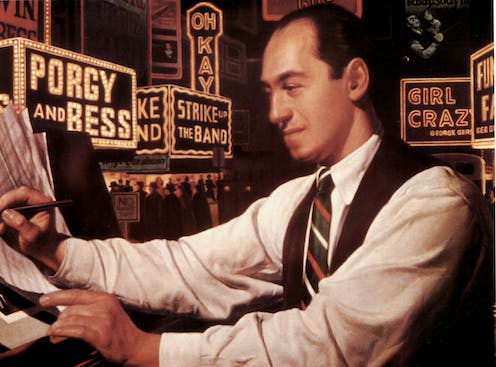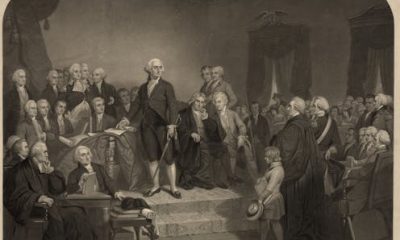
It took George Gershwin just 10 days to pen the American classic. GAB Archive/Redferns via Getty Images
February 12, 1924, was a frigid day in New York City. But that didn’t stop an intrepid group of concertgoers from gathering in midtown Manhattan’s Aeolian Hall for “An Experiment in Modern Music.” The organizer, bandleader Paul Whiteman, wanted to show how jazz and classical music could come together. So he commissioned a new work by a 25-year-old Jewish-American upstart named George Gershwin.
Gershwin’s contribution to the program, “Rhapsody in Blue,” would go on to exceed anyone’s wildest expectations, becoming one of the best-known works of the 20th century. Beyond the concert hall, it would appear in iconic films such as Woody Allen’s “Manhattan” and Disney’s “Fantasia 2000.” It was performed during the opening ceremonies of the 1984 Los Angeles Olympics, and if you ever fly on United Airlines, you’ll hear it playing during the preflight safety videos.
I’ve spent nearly two decades researching and writing about this piece. To me, “Rhapsody” isn’t some static composition stuck in the past; rather, it’s a continuously evolving piece of music whose meaning has changed over time.
Programming “Rhapsody” for concerts today has become somewhat of a double-edged sword. A century after it premiered, it remains a crowd favorite – and almost always guarantees a sold-out show. But more and more scholars are starting to see the work as a whitewashed version of Harlem’s vibrant Black music scene.
A cobbled-together hit
Whiteman commissioned Gershwin to write “Rhapsody” sometime in late 1923. But as the story goes, the composer forgot about his assignment until he read about the upcoming concert in a newspaper on Jan. 4, 1924.
Gershwin had to work quickly, writing as time allowed in his busy schedule. Manuscript evidence suggests that he only worked on the piece a total of 10 days over the span of several weeks.
A copy of the first page of George Gershwin’s manuscript for ‘Rhapsody in Blue.’
Gabriel Hackett/Archive Photos/Getty Images
Accordingly, he relied on the familiar melodies, harmonies, rhythms and musical structures that had started to garner him acclaim as a popular composer for the Broadway stage. This music was increasingly influenced by early jazz, as the improvised, syncopated and blues-infused sound of Black musicians such as Louis Armstrong made its way north from New Orleans. Gershwin also mingled with, and was influenced by, some of the great Harlem stride pianists of the day, including James P. Johnson and Willie “The Lion” Smith.
Despite being quickly cobbled together, “Rhapsody in Blue” ultimately sold hundreds of thousands of records and copies of sheet music. Gershwin’s own performances of the work on tour also helped boost its popularity.
But success also opened up the piece to criticism – particularly that Gershwin had appropriated Black music.
Black musicians feel snubbed
This is not only a 21st-century critique by music historians. Even back then, some Black artists were miffed.
But rather than calling it out in print, they did so through their own art.
In 1929, blues artist Bessie Smith starred in a short film called “St. Louis Blues,” based on the song of the same name by composer W.C. Handy. It features an all-Black cast, including members of the Fletcher Henderson Orchestra and the Hall Johnson Choir. Instrumental and vocal versions of Handy’s song provide the sonic backdrop for this 15-minute film – with one very pointed exception.
Smith plays the part of Bessie, an unrequited lover to a duplicitous gambler named Jimmy. In the final scene, after a previous falling out, Jimmy and Bessie reconcile in a club. They embrace on the dance floor to the strains of “St. Louis Blues.”
But unbeknownst to the love-struck Bessie, Jimmy carefully picks her pocket and unmercifully shoves her back to her bar stool. After Jimmy flashes his newly acquired bankroll, the opening clarinet glissando of “Rhapsody in Blue” begins. During this brief, 20-second cue, Jimmy boastfully backs out of the club, bowing and tipping his hat like a performer acknowledging his ovation.
The short film ‘St. Louis Blues’ takes a subtle dig at Gershwin 14 minutes in.
It’s hard not to see the subtext of introducing Gershwin’s famous piece at this moment: Just as Jimmy has robbed Bessie, the film suggests that Gershwin had pilfered jazz from the Black community.
Another musical response to “Rhapsody” emerged in 1927 from Gershwin’s stride pianist friend, James P. Johnson: “Yamekraw.” Publisher Perry Bradford billed the work as “not a ‘Rhapsody in Blue,’ but a Rhapsody in Black and White (Black notes on White paper).”
Of course, the “black notes” were more than just the score itself. Johnson demonstrates how a Black musician would approach the rhapsody genre.
Stuck in the middle with ‘Blue’
Gershwin once described “Rhapsody” “as a sort of musical kaleidoscope of America – of our vast melting pot.”
The problem with the “melting pot” metaphor is that it asks immigrants to leave behind cultural practices and identities in order to assimilate into the majority population.
And that’s just what Whiteman’s musical experiment at Aeolian Hall a century ago was all about: He sought, as he put it, to “make a lady out of jazz.”
As the concert’s program read, “Mr. Whiteman intends to point out, with the assistance of his orchestra and associates, the tremendous strides which have been made in popular music from the day of the discordant Jazz … to the really melodious music of today.”
In other words, he wanted to fold the era’s popular jazz music into classical music – and, in doing so, draw out the inherent beauty in the beast, making it more acceptable to white audiences.
“Rhapsody in Blue” and other classical-jazz hybrid works like it would soon become known as “middlebrow” music.
This fraught term emerges from the space between the so-called “lowbrow” and “highbrow,” descriptors that locate works of art on a scale from pedestrian to intellectual. These terms originally related to the pseudoscience of phrenology, which drew conclusions about intelligence based on skull shape and the location of the ridge of one’s brow line.
Highbrow music, made by and for white people, was considered the most sophisticated.
But highbrow music could also conveniently elevate lowbrow music by borrowing – or rather, appropriating – musical elements such as rhythm and harmony. Merging the two, the low gets to the middle. But it could never get to the top on its own terms.
If Gershwin’s “Rhapsody” is meant to be heard as a “musical kaleidoscope of America,” it is important to remember who’s holding the lens, what music gets added to the mix, and how it has changed once admitted.
But it’s also important to remember that 100 years is a long time. What the culture values, and why, inevitably changes. The same is true for “Rhapsody in Blue.”
Ryan Raul Bañagale does not work for, consult, own shares in or receive funding from any company or organization that would benefit from this article, and has disclosed no relevant affiliations beyond their academic appointment.
Advertisement

Advertisement
Contact Us
If you would like to place dofollow backlinks in our website or paid content reach out to info@qhubonews.com











